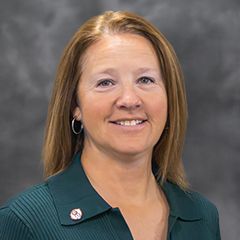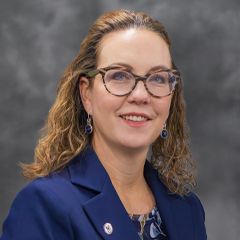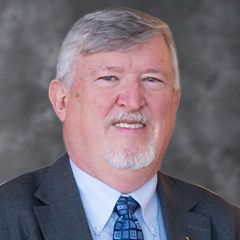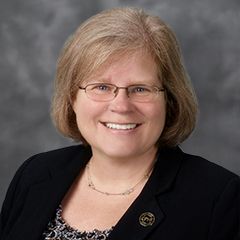Candidates for the 2025-2026 Executive Committee
Elections for the NABP 2025-2026 Executive Committee will be held in May 2025 during the 121st Annual Meeting for the following positions:
- President-Elect (1-year term)
- Treasurer (1-year term)
- Member, District 1 (3-year term)
- Member, District 2 (3-year term)
- Member, District 5 (3-year term)
- Member, District 7 (2-year term)
All eligible individuals will be placed on the ballot.
Read about the nominees for open officer and member positions below.
Officer Nominations
The following candidates have been nominated for the Executive Committee officer positions.

NABP continues to change and adapt to the directions and initiatives advocated by the member boards of pharmacy. As President-Elect, what new areas do you foresee NABP undertaking in order to support its member boards in the years ahead?
The future of pharmacy continues to evolve. In the near term, I envision NABP completing work in areas in which it has started to engage in anticipation of and in response to the new realities of the profession of pharmacy. Maintaining value and relevance, first to our member boards and then to the larger body of stakeholders, specifics would include interstate privilege to enhance license portability, evolving technology and artificial intelligence, and global security and integrity of the drug supply chain through data management. While predicting the more distant future of NABP can be a challenge, I know that the leadership and staff will ensure the member boards are at the heart of the work. NABP will be responsive, serving each with customized solutions for their needs while protecting the public.

Why are you interested in serving NABP in the capacity as treasurer and how would you advise NABP to monitor and prepare for what might be a more global and competitive environment?
I have had the privilege of serving on the NABP Executive Committee for 6 years and on the North Dakota Board of Pharmacy for 12 years. As a rural independent pharmacy owner/operator, I have learned a great deal on the differences of state boards but mostly of what we all have in common, putting our patients first. I feel my daily experiences of rural and critical access pharmacy bring a needed perspective to NABP and its mission of protecting public health. My interest in running for NABP Treasurer is fueled by my passion to see NABP adapt by bringing business-sound, user-friendly tools (i.e, Pulse, eLTP) to our members and remaining in a stable financial position. Stability is essential in serving our member boards in a global and competitive environment during a financially challenging era for our industry.
Member Nominations
The following candidates have been nominated for the Executive Committee member positions by their districts at the respective district meetings.

The expansion of the pharmacist’s role to provide and improve patient care has been under consideration for some time. As a member of the Executive Committee, what regulatory initiatives should state boards of pharmacy and NABP undertake to support such efforts solely in the interest of protecting the public health?
Pharmacists are an important community resource and critical access point to health care in most communities throughout the United States. As the nation struggles with diminishing primary care provider access and increasing complex medication regimens and therapies, the expanded role of pharmacists can and should continue to evolve. Through the pharmacist patient care process, we can leverage new technologies and artificial intelligence to safely support and guide patients when accessing health care. Through a regulatory lens, payment for clinical services and ensuring pharmacy staff wellbeing is a critical initiative. Additionally, supporting and protecting health care data will safely assist the industry and protect the public as we move into the next dynamic chapter of “health.”

The expansion of the pharmacist’s role to provide and improve patient care has been under consideration for some time. As a member of the Executive Committee, what regulatory initiatives should state boards of pharmacy and NABP undertake to support such efforts solely in the interest of protecting the public health?
It is my feeling that state boards of pharmacy and NABP should be moving towards a regulatory framework that loosens rather than restricts the pharmacists’ role in patient care. A large portion of patient care today is data-driven, and pharmacists are taught to evaluate laboratory results as part of their education. Allowing pharmacists to follow protocols based on patient data to initiate and manage medications would encourage innovation and promote better patient care. Pharmacists should be allowed to order and evaluate any test that they feel will better allow them to manage their patient’s medication as part of their normal course of practice. State boards of pharmacy should continually work with practicing pharmacists to expand data-driven patient care protocols for all pharmacists.

The expansion of the pharmacist’s role to provide and improve patient care has been under consideration for some time. As a member of the Executive Committee, what regulatory initiatives should state boards of pharmacy and NABP undertake to support such efforts solely in the interest of protecting the public health?
The greatest impact on the evolving practice of pharmacy is driven by innovation within the profession. As we evolve the role of pharmacists to expanded clinical roles, we should continue to focus on advancement of pharmacy technicians. In recent years, NABP has embraced pharmacy technician innovation and advancement by providing suggestions for regulation standards; however, there is still more that can be done. If elected to the Executive Committee, I will work to support NABP to continue molding the Model Practice Act/Rules and providing the necessary tools to assist boards of pharmacy in setting practice standards. Through this work as regulators, we can strive to ensure everyone working in the pharmacy possesses the knowledge needed to ensure public health and welfare is protected.

The expansion of the pharmacist’s role to provide and improve patient care has been under consideration for some time. As a member of the Executive Committee, what regulatory initiatives should state boards of pharmacy and NABP undertake to support such efforts solely in the interest of protecting the public health?
State boards of pharmacy and NABP should continue working together to develop regulatory initiatives that expand pharmacists’ roles while ensuring public health protection. Updating the reciprocity model to include an interstate privilege framework would enhance license portability, allowing pharmacists to respond to health care needs across state lines and jurisdictions efficiently and increase the utilization of telehealth in pharmacy. Implementing and adopting the uniform Multistate Pharmacy Jurisprudence Examination would standardize legal and ethical competency, streamlining licensure processes. Amid potential federal instability, NABP must reinforce its role in assisting state boards by providing regulatory resources and best practices to maintain oversight and patient safety. As states move to remove delegated authority from pharmacy boards, NABP should work with and educate stakeholders regarding the need to preserve this regulatory role in order to ensure consistent, evidence-based decision-making by state boards. NABP must continue offering critical support to member boards through data-sharing initiatives, compliance resources, and advocacy efforts. Strengthening these frameworks will safeguard public health, promote pharmacist mobility, and maintain regulatory stability in an evolving political and healthcare landscape.